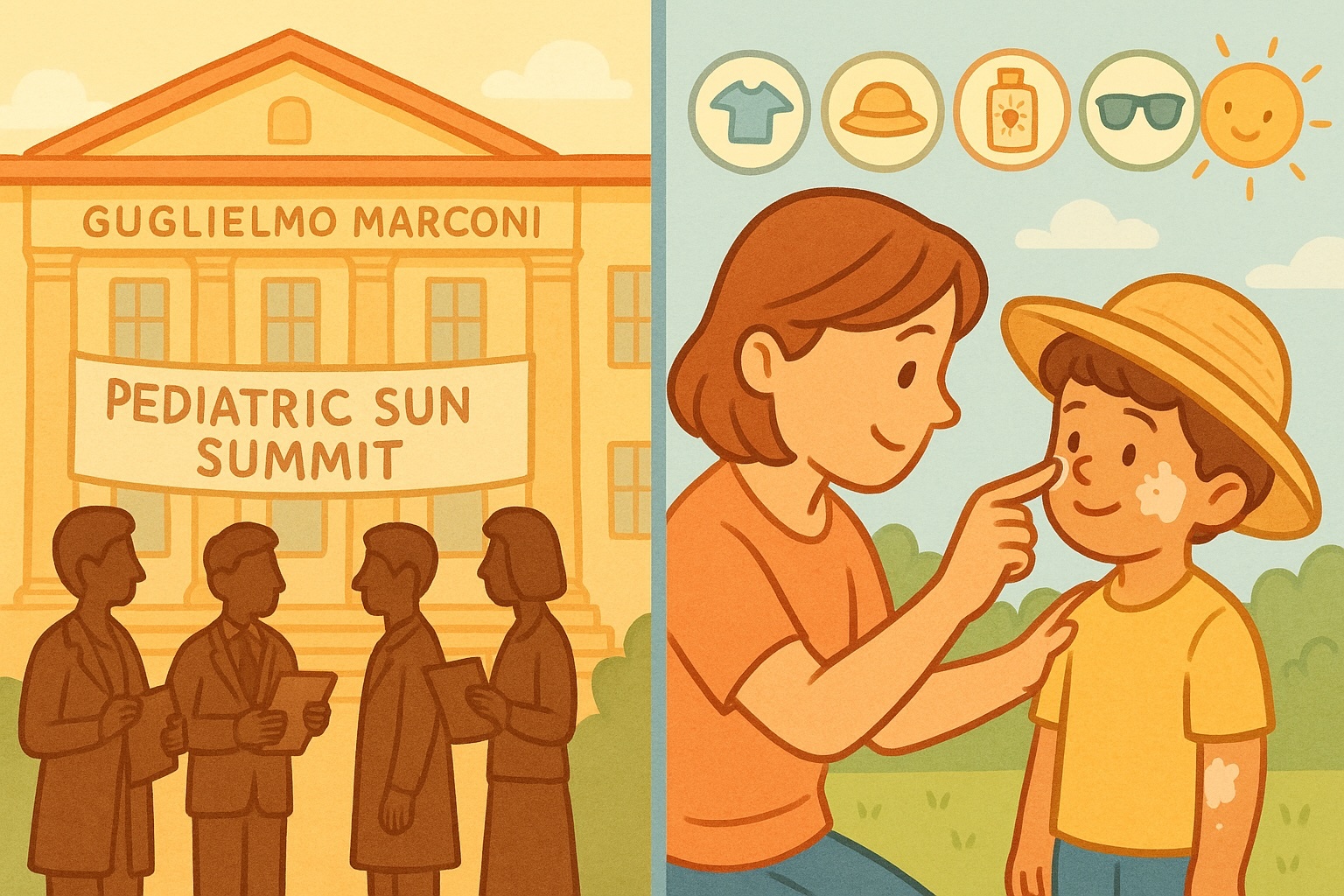New
Pediatric Sun Protection Guidelines In Vitiligo: Balancing Sun Safety and Vitamin D
Guglielmo Marconi University in Rome — alma mater of our Board Chair Prof. Torello Lotti, teaching ground for our CEO Prof. Yan Valle, and the birthplace of World Vitiligo Day back in June 2012 — recently welcomed a summit of dermatologists, paediatricians and photobiologists.
The experts convened to update best‑practice advice on children and sunlight, and their brief letter in the International Journal of Pediatric Dermatology distils decades of research on melanoma prevention, vitamin D biology and modern sunscreen science — precisely the issues parents of kids with vitiligo juggle every sunny season. The answers turn out to be practical, everyday habits — most of which cost nothing and start long before you reach for a bottle of SPF.
TL;DR
- Kids with vitiligo need extra‑gentle sun care: think layers—shade, UPF clothing, brimmed hats, mineral sunscreen, and UV‑blocking shades (the “COCCO” mantra).
- Skip tanning; instead, give them two or three short “sun‑snacks” a week—10–15 minutes outside peak hours—to keep vitamin D humming without burns.
- Most children still need 400–600 IU of vitamin D daily; check levels if they’re high‑SPF all year, have darker skin, or live far from the equator.
- Mineral sunscreens on the whole limb, antioxidant‑rich meals, and kid‑friendly probiotics all help calm skin and reduce contrast.
- Coordinate natural sun, supplements, nutrition, and any prescribed NB‑UVB phototherapy into one balanced plan—safe skin, strong bones, happy kids.
Why It Matters
Vitiligo puts its own spin on the usual sun‑safety chat. First, white patches burn in half the time because there’s no melanin to soak up and deflect UVB. Second, when the surrounding skin tans the contrast deepens, making patches shout louder and denting confidence. The panel’s fresh guidance shows how to shelter those vulnerable areas without blocking the sunlight your child needs for vitamin D — and for repigmentation therapies that depend on a little light.
First Principle: Kids Don’t need a tan
Unlike adults, kids aren’t chasing a bronze glow. Any direct sun they receive should be unavoidable, not intentional.
Make shade, clothing or indoor play the default whenever the UV Index climbs to 3 or above (often late morning through mid‑afternoon).
The COCCO rule: a child-friendly photoprotection mantra
Italian experts teach children the mantra C.O.C.C.O. (pronounced “COT‑cho”). Here’s what that means day-to-day:
- Shirt (Camicia): Choose dark colours, tight weaves or purpose‑built UPF‑50 fabrics. A UPF 50 rash-guard blocks about 98 % of UV rays, compared with ~20 % for a wet cotton tee.
- Shadow (Ombra): When the UV Index hits 3 or higher — roughly 11 a.m. to 4 p.m. from April to September in central Europe — move the fun under a tree, canopy or umbrella. Shade halves the dose, but scattered light still sneaks in, so layer up with the next steps.
- Hat (Cappello): A broad brim shields the scalp, ears and nape, common burn sites in children with vitiligo patches along the hairline.
- Sunscreen (Crema): Mineral (zinc or titanium oxide) creams are preferred for kids; apply a walnut-sized blob to face, one for each arm, two for legs and torso, 30 minutes before going out, then every two hours or after water play.
- Sunglasses (Occhiali): UV 400 or “CE UV 100 %” lenses protect the eyes and the thin periorbital skin, which often contains vitiliginous flecks.
Apply sunscreen only after the first three layers are in place; it’s the last line of defence, not the first.
Smart Sun Time: Just Enough, Not Too Much
Professor Romagnoli’s review flagged a paradox: up to half of European children are vitamin‑D‑deficient even though they live where UVB is plentiful, so the expert panel rejects a “zero‑sun” policy. The sweet spot is a short, planned “sun snack” outside peak hours.
- Infants (< 6 months): keep out of direct sun completely (AAP policy). Rely on supplements.
- Toddlers and young children (6 months–5 years): allow about 10–15 minutes of morning or late-afternoon sun on arms and legs, two or three times a week — quit before skin warms or colours.
- School-age (6–12 years): extend to roughly 15 minutes on the same schedule — still outside peak UV hours.
- Teens (13–18 years): Similar timing works; darker skin may need the full twenty minutes.
These figures echo broader photobiology data suggesting 5–15 minutes on 25 % of body surface, 2-3 times weekly, maintains vitamin D sufficiency in fair to medium skin.
Remember: take these as starting points. Cloud, pollution, latitude, season and skin tone nudge the dial up or down.
When Sunshine Isn’t Enough: Vitamin D in Plain Language
International nutrition panels set the daily dietary requirement at 400 IU (10 µg) for infants and 600 IU (15 µg) from the first birthday through adolescence.
In real life that means:
- Babies (0-12 months) almost always need a 400 IU liquid drop, because breast milk and formula rarely reach that level.
- Children 1-8 years who get minimal midday sun or habitually wear SPF 50 every day should top up with a 600 IU chewable or gummy.
- From 9 years onward, 600–1 000 IU tablets cover most needs; the safe upper limit is 4 000 IU unless your paediatrician prescribes otherwise.
Ask your paediatrician for a 25‑hydroxy‑vitamin D blood test every 6–12 months if your child has extensive vitiligo, darker skin or lives above 40° N.
Sunscreen Nuance for Vitiligo Patches
Depigmented areas are often dry and sensitive. The panel — and many national regulators — recommend non-nano zinc or titanium oxide pastes; they sit on the surface, scatter the full UV spectrum and rarely sting. Organic “chemical” filters such as oxybenzone can enter bloodstream and have been linked (mainly in lab models) to endocrine effects, so reserve them for older teens who refuse “white cast” creams.
Pro tips:
- Cover the entire limb, not just the white spots — this prevents background tanning that accentuates contrast.
- Blend the cream a few millimetres beyond each lesion’s edge; abrupt stop-lines are a common aesthetic complaint during repigmentation therapy.
- Treat sunscreen as a seat-belt: essential but not a licence to drive faster. Teach children to reduce rather than extend their time in intense sun once they are lotioned up.
A couple of insider tricks: cover the whole limb, not just the spots, so background skin doesn’t tan and shout “contrast!”; blend the cream a few millimetres past each patch to dodge sharp edge lines. And remember sunscreen is a seat‑belt, not a speed pass — once lotioned up, shorten sun time rather than stretch it.
Clothing: The Forgotten SPF
Regular cotton blocks only about a fifth of incoming UV. Purpose‑made UPF‑50 gear flips the numbers, letting in just two per cent.
On beach days a long‑sleeve UPF‑50 swim top and leggings let a child with vitiligo play longer with fewer messy top‑ups.
Phototherapy, Heliotherapy and Vitiligo
Modern narrow-band UVB (311 nm) phototherapy remains a gold-standard treatment for widespread vitiligo — but it must be delivered in specialist units. The Rome panel emphasised no clinic-based UVB before age 16, and advised against home “sun-lamp” substitutes.
If your dermatologist schedules NB-UVB:
- Keep a diary of any outdoor sun time; cumulative dose matters.
- Apply sunscreen to non-treated regions to avoid patchy darkening.
- Continue vitamin D drops, because therapeutic NB-UVB targets skin locally and may not correct systemic deficiency.
Nutrition: Feeding The Skin From Within
Photoprotection also happens at the dinner table. A diet rich in antioxidant vitamins (C, E, A), polyphenols, flavonoids and carotenoids, plus micronutrients such as zinc, selenium and copper, scavenges the oxidative stress that drives both sun damage and vitiligo. Systematic reviews link oral antioxidants to smaller sun-burn areas and better outcomes when combined with phototherapy.
Emerging data on the gut–skin axis add probiotics to the toolkit; certain Lactobacillus and Bifidobacterium strains appear to calm inflammation and may even enhance UV resistance.
Practical grocery list
- Rainbow of fruit and veg (berries, kiwis, oranges, spinach, carrots, sweet potato)
- Nuts and seeds for vitamin E and selenium
- Fatty fish or fortified dairy for vitamin D backup
- Live-culture yoghurt, kefir or a child-specific probiotic if your paediatrician approves
- Whole grains and pulses for copper and flavonoid diversity.
A Day In The Life: Putting It All Together
- Morning: Check the UV‑Index. If it’s three or higher, pack the COCCO kit—UPF shirt, brimmed hat, mineral sunscreen, child‑sized shades—and coat face, neck, hands and any patchy zones. Set a reminder for the two‑hour top‑up.
- Mid‑morning sun snack: Ten‑ish minutes of open‑air play while UV is still gentle, sleeves rolled to elbows, pant legs to knees—usually enough for vitamin‑D production.
- Mid‑day to mid‑afternoon: Retreat to shade or indoor adventures; lean on clothing as the main shield.
- Late afternoon: Optional second sun snack if the morning slot was missed—keep it under fifteen minutes.
- Evening: Bath, gentle emollient on vitiligo areas, tick the calendar if it was an NB‑UVB day.
Five Quick Takeaways
- Shade and clothing first; sunscreen last.
- Children should never sun‑bathe for colour.
- Planned “sun snacks” keep vitamin D topped up without risking burns.
- Antioxidant‑rich foods and probiotics add an internal layer of defence.
- Coordinate natural sun, supplements and any medical phototherapy as one balanced plan.
Sunlight isn’t friend or foe; it’s a tool. With these habits in place, your child can explore a sunny world safely, keep their bones strong, and give vitiligo patches the calm environment they need to heal.

Participants: Fabio Arcangeli, Raimonds Karls, Torello Lotti, Giuseppe Monfrecola, Christopher, Rowland Payne, Costantino Romagnoli, Giuseppe Ruggiero, Liliana Sytnyk, Uwe Molina
Continue the Journey
- Expert Recommendations on Pediatric Vitiligo Care
- Diet, Microbiome, and Vitiligo: Unveiling the Mystery
- The Real Price Tag of Treating Vitiligo: What You Need to Know
Listen to Podcast
- When Spots Start Young (Ep. 34)
- Let's Talk Vitiligo and Beauty During Pregnancy (Ep. 33)
- Vitiligo and Pregnancy: The Complex Connection (Ep. 14)

FAQOther Questions
- Is there a link between vitiligo and depression?
Depression and anxiety are often linked with vitiligo, significantly impacting a person’s quality of life. The connection stems from the shared origin of the skin and brain duri...
- Awareness Days Similar to World Vitiligo Day
World Vitiligo Day, celebrated annually on June 25 since 2012, is a significant event dedicated to raising awareness about vitiligo and supporting those affected by the conditio...
- Which is better for judging vitiligo — Wood’s lamp or dermoscopy?
A recent study out of India compared the two head-to-head. Both tools correlated fairly well with clinical criteria, but dermoscopy had a slight edge: Wood’s lamp: sensitivit...
Though it is not always easy to treat vitiligo, there is much to be gained by clearly understanding the diagnosis, the future implications, treatment options and their outcomes.
Many people deal with vitiligo while remaining in the public eye, maintaining a positive outlook, and having a successful career.
Copyright (C) Bodolóczki JúliaBy taking a little time to fill in the anonymous questionnaire, you can help researchers better understand and fight vitiligo.
